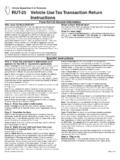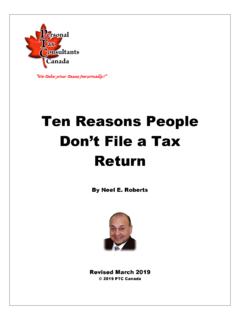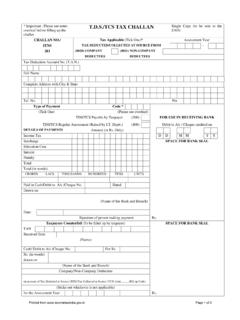Transcription of FORUM ON TAX ADMINISTRATION - OECD.org
1 ORGANISATION FOR ECONOMIC CO-OPERATION AND DEVELOPMENT. FORUM ON TAX ADMINISTRATION . Guidance Note: Guidance for the Standard Audit File Tax Version April 2010. CENTRE FOR TAX POLICY AND ADMINISTRATION . Guidance for the Standard Audit File Tax Version TABLE OF CONTENTS. SUMMARY ..5. RECOMMENDATIONS ..5. GUIDANCE FOR THE STANDARD AUDIT FILE TAX VERSION ..7. 1. Introduction ..7. 2. Application of SAF-T ..7. 3. SAF-T and its uses in tax audit ..8. 4. Benefits to Stakeholders ..9. 5. Content of SAF-T ..9. 6. Format of SAF-T ..10. 7. Implementation of SAF-T ..11. 8. Country-specific 9 Recommendations for Guidance and Implementation Tasks ..12. ANNEX A: COUNTRY-SPECIFIC IMPLEMENTATIONS OF SAFS: TECHNICAL NOTES ..14. 1. Main principles ..14. 2. Extension Mechanisms ..14. 3. Constraints ..15. ANNEX B: SAF-T VERSION XML SCHEMA ..16. 2. Guidance for the Standard Audit File Tax Version ABOUT THIS DOCUMENT. Purpose The purpose of this paper is to describe the design, in the form of a XML schema, of a Standard Audit File - Tax (SAF-T) and its implementation.
2 The objective is to enable business and accounting software to create a SAF-T, containing reliable transaction data from systems that covers a specific time period and which is easily readable by virtue of its standardisation of layout and format. SAF-T advances efficient and effective audits by internal and external auditors and by revenue bodies. Background to the FORUM on Tax ADMINISTRATION The FORUM on Tax ADMINISTRATION (FTA) was created by the Committee on Fiscal Affairs (CFA) in July 2002. Since then the FTA has grown to become a unique FORUM on tax ADMINISTRATION for the heads of revenue bodies and their teams from OECD and selected non-OECD countries. In 2009 participating countries developed the FTA vision setting out that The FTA vision is to create a FORUM through which tax administrators can identify, discuss and influence relevant global trends and develop new ideas to enhance tax ADMINISTRATION around the world.
3 This vision is underpinned by the FTA s key aim which is to improve taxpayer services and tax compliance by helping revenue bodies increase the efficiency, effectiveness and fairness of tax ADMINISTRATION and reduce the costs of compliance. To help carry out this mandate, the FTA s work is directly supported by specialist Sub-groups . including the Tax e-Audit Group whose work is directed at developing internationally agreed software standards designed to facilitate: a reduction of compliance costs for businesses;. a reduction of administrative costs for revenue bodies;. the enhancement of the outcomes of audits of businesses carried out by revenue bodies; and the provision of a platform to make it easier for revenue bodies to co-operate in areas such as joint audits. Background to this Guidance Note This guidance note has been produced in co-operation with representatives from revenue bodies, the accountancy and audit professions, and software developers.
4 The note deals with the technical aspects of the SAF-T, and provides detailed information on the key data elements of the file, together with its structure and format. This note should be read in conjunction with the companion OECD guidance notes Guidance and Specification for Tax Compliance of Business and Accounting Software (GASBAS)1 and Guidance on Test Procedures for Tax Audit Assurance .2. 1. OECD (2010) 2. OECD (2010) 3. Guidance for the Standard Audit File Tax Version One of the main principles set out in GASBAS is that software should allow auditors ready access to data to perform compliance and substantive testing, including self-testing. GASBAS also recommends the use of SAF-T as a means of exporting accurate tax accounting data in a format that can be easily read by revenue bodies. The Guidance on Test Procedures for Tax Audit Assurance contains a detailed inventory of audit tests. SAF-T can facilitate both compliance and substantive testing.
5 This guidance note also builds upon earlier papers published in the OECD FTA Tax Guidance series: Transaction Information This provides, inter alia, both a guide to international good practice and a list of key data elements that would aid substantive testing of internal controls and facilitation of compliant Record Keeping It is an essential pre-requisite for testing using the SAF-T for it to contain reliable records. A reliable electronic record is a record whose contents can be trusted as a full and accurate representation of the transaction. In order to achieve the appropriate level of trust, the record should also display sufficient levels of authenticity, integrity, and usability. This is most likely to be achieved by a combination of strong internal controls on data processing together with the application of suitable security techniques that ensure the reliability of the subsequent data output. Caveat Each revenue body faces a varied environment within which they administer their taxation system.
6 Jurisdictions differ in respect of their policy and legislative frameworks and their administrative practices and culture. As such, a standard approach to tax ADMINISTRATION may be neither practical nor desirable in a particular instance. The documents forming the OECD tax guidance series need to be interpreted with this in mind. Care should always be taken when considering the practice of a country to fully appreciate the complex factors that have shaped a particular approach. Enquiries and further information Enquiries concerning any matters raised in this guidance note should be directed to 3. OECD (2003) 4. International Organization for Standardization (ISO) (2001) ISO 15489-1:2001 Information and documentation -- Records management -- Part 1: General, ISO, Geneva, Switzerland. 5. OECD (2005) 4. Guidance for the Standard Audit File Tax Version SUMMARY. 1. This document describes the specification of the Standard Audit File for Tax (SAF-T), and provides guidance to revenue bodies and software developers on its design, application and implementation.
7 2. It encourages the production of a data file containing business accounting transactions in a standardised format. It also suggests how use of SAF-T can be applied to tax audit processes to enable them to be carried out with greater efficiency and in such a way that costs to both revenue bodies and businesses can be minimised. 3. The document also lists a number of potential benefits to stakeholders that may accrue by use of SAF-T in business accounting software. 4. The options for implementation of the specification by tax administrations, either directly or in partnership with others, are also examined. The implementation tasks identified and summarised in the document are aimed at both software developers and revenue bodies. RECOMMENDATIONS. 5. Each FTA country is faced with a different environment in respect of policy, legislation, ADMINISTRATION and culture, which will have shaped their taxation systems. It is therefore up to each country to decide how to approach the issues addressed in this report and the most appropriate response to the challenges identified.
8 Recommendations are broken down into two parts, recommendations for revenue bodies and recommendations software developers. Recommendations are in the order that they appear in the guidance note (not necessarily in order of importance). 6. Revenue bodies are encouraged to: Incorporate the SAF-T into their audit and verification methodologies for tax audits. Become aware and keep abreast of the on-going development of XBRL, which could give a more holistic approach to audit automation, and take this into consideration when formulating their overall strategic approach in this area. Work with Software Developers to establish a common understanding of how to implement the SAF-T schema. Work with Software Developers to establish a common understanding of how and when a data file based on the SAF-T specification should be produced. Ensure that implementation of the SAF-T in their jurisdiction is compatible with the OECD. specification.
9 5. Guidance for the Standard Audit File Tax Version 7. Software Developers are encouraged to: Incorporate the SAF-T specification into their business and accounting software products. Work with revenue bodies to establish a common understanding of how to implement the SAF-T. schema. Work with revenue bodies to establish a common understanding of how and when a data file based on the SAF-T specification should be produced. Provide an easy export facility of the SAF-T to enable testing and analysis. 6. Guidance for the Standard Audit File Tax Version GUIDANCE FOR THE STANDARD AUDIT FILE TAX VERSION 1. Introduction 8. Revenue bodies have for many years conducted tests on accounting records in order to be assured that business tax obligations have been met. Globalisation of the world economy, including the emergence of electronic commerce, has created a new environment in which multi-national businesses are subject to a number of differing legislative requirements around the world.
10 Revenue bodies also see an increased need for international cooperation through the exchange of information and, where appropriate, multi- jurisdictional audit. 9. One of the main principles set out in the Guidance Note Guidance and Specification for Tax Compliance of Business and Accounting Software (GASBAS)6 is that the software should allow auditors ready access to data to perform compliance and substantive testing. 10. In May 2005 the OECD Committee on Fiscal Affairs (CFA) published the first version of the SAF-T guidance. This version was based on entries as found in a General Ledger Chart of Accounts, together with master file data for customers and suppliers and details of invoices, orders, payments, and adjustments. The revised version ( ) in this document has been extended to include information on Inventory and Fixed Assets. The opportunity has also been taken to enhance the original SAF-T. specification to take account of suggestions from OECD member countries and others.
















